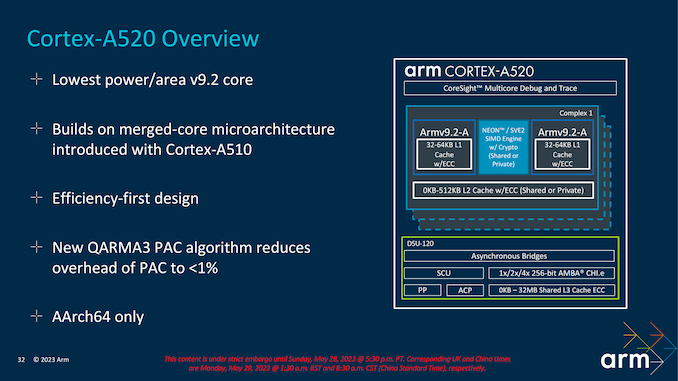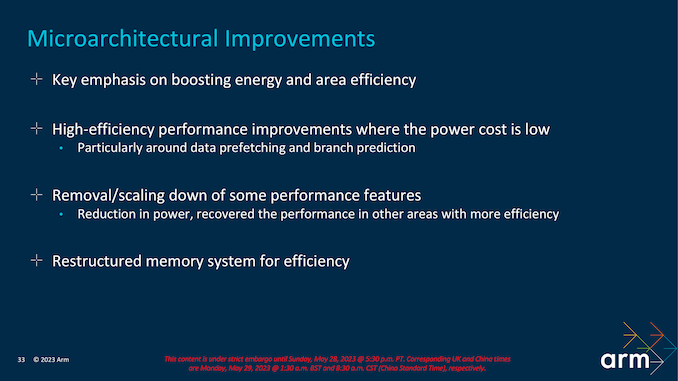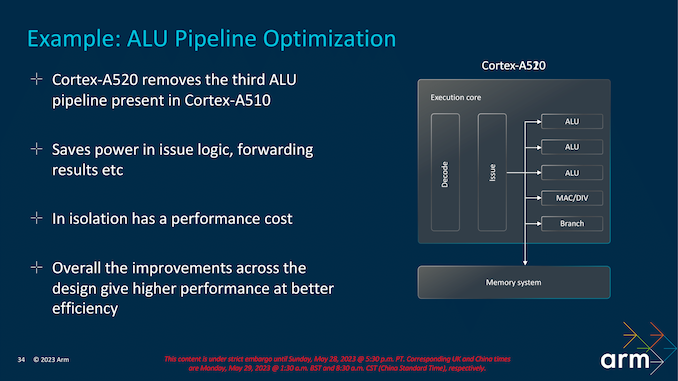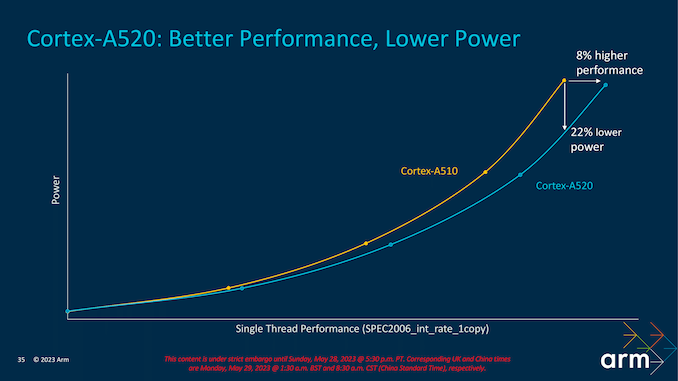Arm Unveils 2023 Mobile CPU Core Designs: Cortex-X4, A720, and A520 - the Armv9.2 Family
by Gavin Bonshor on May 28, 2023 8:30 PM ESTCortex-A520: LITTLE Core with Big Improvements
The third of the Armv9.2 cores is the Cortex-A520, which is little in design, but Arm promises big improvements over previous generations, particularly on power efficiency.
Addressing the biggest question right off the bat: no, Cortex-A520 is not an out-of-order core design. True to Arm's little core design ethos, it's still an in-order core – and in fact, Arm has even removed an ALU in the process.
Arm's smallest core for this generation is a new core in effect, but it is still more of a refinement of the Cortex-A510 than a completely new design. It has the lowest power-to-area ratio of all three announced Cortex Armv9.2 cores. The most significant differences come through optimizations on power, with Arm claiming that the Cortex-A520 is 22% more energy efficient than the previous Cortex-A510 core at iso-process and iso-frequency. The little core in Arm's TCS23 catalog is primarily designed for performing low-intensity and background operational tasks, which takes these loads off bigger cores such as the Cortex-A720/Cortex-X4 to allow better power efficiency overall within the cluster.
Many of Arm's efficiency gains come from small, microarchitectural level changes, mostly around how it implements data prefetch and branch prediction. On the whole, not much has been changed to the little core, but the small changes that have been made have all been about improving efficiency.
One of the non-architectural areas of improvement has been introducing the new QARMA3 Pointer Authentication Code (PAC) algorithm, which Arm claims to reduce PAC's overhead to under 1%. QARMA3 is a cryptographic-based technique designed to ensure the pointers' integrity is correct and accurate. It also provides a secure and efficient way to avoid tampering with the necessary underlying code so that any authorized modifications or tampering if the pointers are eliminated adds a layer of hardware-level security. Arm is not only leveraging QARMA3 PAC to boost security and integrity, but it also allows them to squeeze out additional levels of efficiency, if compared to using PAC with older algorithms.
Much like when Arm announced its armv9 architecture in 2021, the small Cortex-A520 cores can be merged in pairs to share pipelines and improve efficiency. Adopting a pairing of the smaller Cortex-A520 cores can enhance efficiency by combining them through relevant pipelines such as SVE, NEON, and FP. More so in the case of SVE2, which does require a larger area footprint than other executions and makes sense to pair two smaller cores than have just one on its own. However, it is entirely plausible and possible for SoC vendors to use single-core option implementations on their designs if they wish to do so.
Sometimes less is more, and in the case of the Cortex-A520, Arm has removed the third ALU pipeline, which it originally added to the Cortex-A5x DNA with the Cortex-A510. Arm's ideology behind this is it saves power in issue logic and improves forwarding results within the overall complexity of the pipeline. In practice, Arm has figured out how to recover enough of the lost performance through other improvements that they are opting to eat the hit from removing the ALU in order to minimize core size and maximize efficiency.
Ultimately, Arm is looking at a big-picture trade-off as well; reducing the power consumption of the Cortex-A520 frees up energy that can be allocated to the other cores, such as the Cortex-A720 and even the Cortex-X4 where applicable. This makes Armv9.2 IP versatile and scalable, making small savings where it can deliver the savings in other areas where and when it is needed.
Using SPEC2006_int_rate_1copy as its performance metric to judge performance and efficiency, generation on generation (and at iso-process and iso-frequency), Arm is claiming the Cortex-A520 delivers 8% more performance than the Cortex-A510 at similar levels of power consumption. Alternatively, at iso-performance, Cortex-A520 can deliver a significant 22% power savings.
While seemingly small, it can add up in the grand scheme of things, especially across a four-core complex of Cortex-A520 cores. Although there's always a diminishing level of returns in terms of increasing core count when it comes to performance, having lower-powered and more efficient cores typically creates more power for other areas to tap into, such as the big Cortex-X4 core, which requires more grunt to boost those intensive and burst reliant workloads.














52 Comments
View All Comments
Silver5urfer - Monday, May 29, 2023 - link
It is not related to the UI, it is related to the worst practices in ARM, Apple.Disposable goods, non compute focused, rather a simplistic tool for the Technological dependency rather than using it like a computer and most importantly, owning your own data in the case of an ARM powered smartphone - Filesystem, Applications control Etc. None of these are present in iOS. And they are now incorporated into the Android heavily from the UI, Design philosophy, Technology.
Axing 32Bit OS / Applications and forcing everyone to be on the Playstore mandated policies gives an edge to Android on axing the power user features, i.e targeting latest OS SDK means you are restricted heavily to an OS and its jail. Also they are hiding applications now on Playstore. That means old apps are now hard to find, and good apps do not work on latest OS (Timey app for eg), and lot of examples. Plus now modern Android blocks you even on Sideload notifying the SDK target version in normal terms such as this app won't work properly because Android 14 and up do not allow Android 6 below apps.
Windows enjoys the superior user retention and proper computing because of it's legacy support, A Windows 3.1 .exe will work on Windows 10. But on Apple it's all outdated and even hardware, any x86 processor from Core2Quad which lacks SSE4 and AVX2 still runs modern games which utilize these features but can be made to work because of the power of x86 and Windows. That's how a superior computer is born but not guardrails and heavy restriction and placing consumer in the dark in the name of technology BS.
Eliadbu - Monday, May 29, 2023 - link
Legacy support is overrated for vast majority of the user base, even on windows. its also a thing that can be achieved with emulation for the niche use cases. Most of the argument you gave had little to non to do with 32 bit support. This legacy support costs in silicon space, complexity and software upkeep - all of those resources can be used for actually useful things that will benefit most users.TheinsanegamerN - Wednesday, May 31, 2023 - link
LMAO legacy support is the only reason windows still exists.iAPX - Monday, May 29, 2023 - link
Intel is thinking about being 64bit-only too, with the X86S project.This is an interesting way, as 16bit and 32bit compatibility could be offered through software emulation in a VM (their proposal), naturally with impact on performances.
Silver5urfer - Monday, May 29, 2023 - link
I hope that project doesn't fly but looking at modern Intel with their ARM clone of P+E to worst now P+E+LPE cores they may break the whole 32Bit Application world.Only HPC market can stop it but looking at how Windows 10 is now being retired by 2030 max (LTSC 1809 maximum lifecycle) add maybe ESU channel like Win7 to 2033 at best, after that I think Windows will also copy Apple hard they are already doing it hardcore as Windows 11 is the Win10S branched out because those internal designers are cultists of the Applesque systems lock down and uber simplification of power user nature, this makes entire generations of young population being dumbed down by the basic structure of the OS + Technology rather than innovative and explorative thinking process of the older era (XP, 7 etc)
Windows 10 is the last Microsoft OS that has real support of all the older Windows applications, 11 discarded a lot of Shell32 / Win32 systems and ruined the NTKernel in the process and the CPU schedulers. They sabotaged the entire explorer.exe too, and with the modern fad AI introduction into the OS the telemetry will explode into exponential factor and with the complete dumbing down of the OS and the process, Atomization of the human thinking will lead to regressive computation. Really unfortunate.
Emulation means there will be a performance penalty.
stephenbrooks - Monday, May 29, 2023 - link
I'm interested by the ARM laptop direction (the 10 X4 plus 4 mid-core design). That could run a full OS like Windows or Linux.eastcoast_pete - Monday, May 29, 2023 - link
At least Gavin addressed the mini-elephant in the room for the small cores (thanks!): still no out-of-order design. Instead, an ALU is removed "for greater efficiency". By now, I am suspecting that ARM and Apple have some kind of understanding that ARM little cores won't, under any circumstance, be allowed to come anywhere close to challenging Apple's efficiency cores in Perf/W. Apple's efficiency cores have about twice the IPC of the little ARM cores and all at about the same power draw. Which made the impossible come true: I am now rooting for Qualcomm to kick ARM's butt, both in court and in SoCs.name99 - Monday, May 29, 2023 - link
Oh FFS, always the conspiracy theories!It’s really much simpler — Apple’s small cores are much larger than ARM’s small cores. ARM seems to be thinking that their mid cores (A720) can play the role of Apple’s small cores, and that may be to some extent true in that Apple can split work between big and small in a way that Android cannot, given that Apple knows much more about what each app is doing (better API for specifying this, and much more control of the OS and drivers).
Much more interesting is how this is all about essentially catching up to Apple’s M series. Which is fine, but if you look at what Apple is doing, the action is all at the high end. I’ve said it before and will say it again; Apple has IBM-level performance in its sights. The most active work over the past three years is all about “scalability” in all its forms, how to design and connect together multiple Max class devices to various ends. The next year or two will be wild at the Apple high end!
Kangal - Monday, May 29, 2023 - link
Thank you!However, I still welcome the development of a smaller and slower ARM core, if it means small power draw and small silicon area. There is a market for that outside of phones; in embedded devices, watches, wearables, and ultra low power gadgets.
We used to have something like Cortex-A7 (tiny), Cortex-A9 (small), Cortex-A17 (medium). Then we had Cortex-A35 (tiny), Cortex-A53 (small), Cortex-A73 (medium). But we never got a successor for the Cortex-A35, so perhaps a very undervolted Cortex-A520 will work. Just like how ARM justified using an overclocked Cortex-A515 as a legitimate successor to the Cortex-A53 range.
Almost all the attention goes to the (Medium) cores. It's their bread and butter. From the development of (2016) Cortex-A73, A75, A76, A77, A78, A710, A720 (2023).
But as you said, the exciting things are happening at the high-end (LARGE) cores. It's started with the creation of a new category in the X1, X2, X3, X4 designs. They seem unfit in phones, okay in tablets, and necessary for ARMbooks. Even then, their performance is somewhere far from Apple's M1/M2/M3 and unfit to tackle AMD Zen3 / Intel 11th-gen x86 cores. Let alone their newest variants.
back2future - Tuesday, May 30, 2023 - link
"Even then, their performance is somewhere far from Apple's M1/M2/M3 and unfit to tackle AMD Zen3 / Intel 11th-gen x86 cores."without sufficient support for desktop OS on desktop performance CPUs it reduces possibilities to binary translation/multiarch binaries and ISA specific OS from vendors, but not on ARM generally having a free choice for Windows/Linux/Unix variants that suit individual needs (work&development/media/gaming)